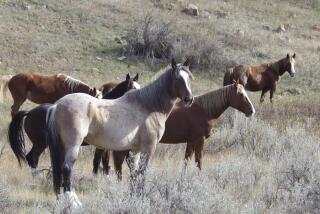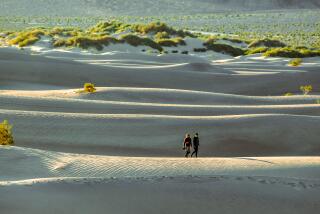Teddy’s National Park
- Share via
MEDORA, N.D. — Tucked away at the western edge of North Dakota, among endless prairies and grasslands and far from any large cities, Theodore Roosevelt National Park is among the least visited of all our national parks--a fate that is ill-deserved because a trip here promises open land, abundant wildlife and very few people.
But those weren’t the only features I found attractive.
I was also interested in how the land had shaped the political life of Theodore Roosevelt, particularly his conservation policies. As president, Roosevelt’s conservation legacy is arguably unmatched: more than quadrupling national forest lands; creating wildlife refuges, bird reserves and national monuments and adding five national parks. Appropriately, Roosevelt Park not only honors the geological eccentricities of the North Dakota badlands, it pays tribute to our 26th president, who came here first in 1883 to hunt buffalo and later to establish two cattle ranches.
Whether it was campaign rhetoric or the truth, Roosevelt said, “I never would have been president if it had not been for my experiences in North Dakota.”
The 70,000-acre Theodore Roosevelt National Park is divided into three areas rather unglamorously referred to as the south and north units and the Elkhorn Ranch site. My family and I arrived in Medora (population 100), gateway to the park’s south unit, well after dark last August. With the full moon guiding us, we drove a winding, deserted road for about six miles, and then pitched our tents at the Cottonwood Campground. We fell asleep to soothing breezes.
At dawn the next morning, I crawled out of our tent to see where we were. Under polished blue skies I witnessed beige, eroded hills rising around the campsite nestled among--no surprise--cottonwood trees. The Little Missouri River flowed past the campground; a doe and two fawns slipped into a nearby stand of trees.
Hoping for a look at some wildlife, which is more active at dawn than during the heat of the day, I woke my 14-year-old son, Brandon, so we could cruise the 36-mile paved loop that circles the south unit. Shrubs and grasses and occasional clumps of trees grew over the colored rock broken up into hills, canyons, valleys, plains and prairies.
I drove slowly so we could take a good look at the land the Sioux Indians called makoshika (the bad lands). U.S. Calvary Gen. Alfred Sully likened the land to “Hell with the fires put out.” Artist Frederic Remington described it as “a place for stratagem and murder.”
But to Theodore Roosevelt, North Dakota’s badlands were “a land of vast silent places--a place of grim beauty.” My son and I looked for mountain lions on the tawny rocks, and elk, bison, mules, white-tailed deer and wild horses in the open areas. We spotted several deer and one massive bison grazing next to the road.
In the afternoon the four of us--including my 15-year-old son, Justin, and my wife, Theresa--explored Medora, founded in 1883 by the Marquis de Mores, a French nobleman who named the town after his beautiful wife. By 1884, the Marquis had built a large packing plant where cattle were slaughtered and shipped east in railroad cars.
That same year, de Mores built his North Dakota chateau, a 27-room frame farmhouse overlooking the river.
De Mores and Theodore Roosevelt first met in 1884, and though Roosevelt was not fond of him, the two got along cordially and records indicate that Roosevelt dined at the chateau on several occasions. Today, Chateau de Mores is a state historic landmark and tours are given daily.
*
Strolling the wooden sidewalks of Medora takes one back to Roosevelt’s years here. Many of the downtown stores have been designed to duplicate that era. We stopped to look around the stores, which sell a variety of Western crafts, souvenirs and clothing, as well as leather goods, ice cream cones and Mt. Rushmore taffy. While the scene sounds a bit tacky, it was actually kind of fun--sort of like being on a movie set, but at an authentic location.
We bought groceries at the Joe Ferris store, once owned by the man who led Roosevelt on his first buffalo hunt. The place has been restored to look as it did when Roosevelt used to visit and sometimes spend the night upstairs. The friendly cashier told us of the long friendship between Ferris and Roosevelt; she even pulled out a copy of a letter Roosevelt had written to Ferris.
With Ferris as his guide, Roosevelt took a full week to bag a buffalo. They traveled over torturous terrain in a nearly constant rain. Roosevelt missed twice, but when he finally shot a buffalo he performed a wild dance.
“I never knew anyone so pleased in my life,” Ferris said later.
At the park’s visitor center, we browsed a nice museum dedicated to Roosevelt’s years in the badlands. Displays cover clothing and other personal items of the era, and tell many Roosevelt tales.
One famous story speaks of Roosevelt spending three days on the Little Missouri River chasing down thieves and six days traveling back upstream with the culprits. They had only stolen a small boat, but for Roosevelt it was a matter of principle: “To submit tamely or meekly to theft or any other injury is to invite almost certain repetition of the offense,” he wrote.
Another day, following a vague mimeographed map given to us by the rangers, we set off for Roosevelt’s ranch, Elkhorn, driving 21 miles over dirt roads through rough, barren country, following the winding course of the Little Missouri River. We then ventured down a private road (with permission), passed through an electric gate and parked a quarter mile from the river.
From there I waded across the river, followed a faint two-track path for a mile, and climbed a small ladder over a barbed wire fence. After walking another half-mile, I came to the ranch.
There wasn’t much to see: the foundations for the house and Roosevelt’s blacksmith shop and a little display showing the ranch as it looked in Roosevelt’s day. For me, the experience was more a pilgrimage than a sightseeing expedition and, I admit, most people would be disappointed by what is (and isn’t) there.
But the site was beautiful and remote, with more than a mile of frontage on the Little Missouri. I could visualize the house, sheltered by a grove of cottonwoods, surrounded by the hills of the badlands. The ranch was begun in 1884 and completed in the summer of 1885. It was considered among the finest houses in all of the badlands.
Of the ranch, Roosevelt wrote: “In the hot noontide hours of midsummer the broad ranch veranda, always in the shade, is almost the only spot where a man can be comfortable; but here he can sit for hours at a time, leaning back in his rocking chair, as he reads or smokes, or with half-closed, dreamy eyes gazes across the shallow, nearly dry riverbed to the wooded bottoms opposite, and to the plateaus lying back of them.”
*
When Roosevelt came here in 1885, he was mourning the unexpected deaths of his wife and mother, both of whom had died on the same night in 1884. He was also suffering political defeat for supporting Chester Arthur as Republican presidential candidate. James Blaine, who lost to Grover Cleveland, won the nomination.
The two summers Roosevelt lived in the badlands were good to him. He loved the cowboy life, and the loneliness of the area suited him fine. Riding his horse on the range, hunting and writing, he felt “as absolutely free as a man could feel.”
*
Roosevelt’s love of nature, of course, did not begin in North Dakota. But it has been documented through speeches and writing that his appreciation of nature deepened in the badlands. As I stood at the site of his Elkhorn Ranch, I could sense how the forlorn beauty of the land affected him. “The country is growing on me, more and more,” he wrote in a letter to his sister, Anna Roosevelt. “It has a curious, fantastic beauty of its own.” This beauty stayed with Roosevelt even after he left the badlands, after the bad winter of 1886-’87 when he lost much of his cattle herd.
For Theodore Roosevelt, the badlands were not financially rewarding, but he gained something even more valuable. Living the life of a cowboy, he developed robust health and was able to cope with the deaths of his wife and mother. The grim beauty of the area impressed him deeply.
Standing there, looking out over the Little Missouri valley, it was easy to understand Roosevelt’s fascination. I felt it too.
(BEGIN TEXT OF INFOBOX / INFOGRAPHIC)
GUIDEBOOK: Teddy’s Park
Getting there: United, Northwest and Frontier fly to Bismarck, with a change of planes in either Denver or Minneapolis. Advance-purchase round-trip fares start at about $365. From Bismarck, drive west on Interstate 94. Visitor centers are located at Medora and Painted Canyon, off ofInterstate 94, east of Medora.
Where to stay: These lodgings were offered by local tourism officials; I did not stay overnight in them.
Badlands Motel, P.O. Box 198, Medora, ND 58645; rates, $70 for a double; telephone (800) MEDORA1.
Sully Inn, P.O. Box 466, Medora, ND 58645; rates: $50 for a double; tel. (701) 623-4455.
Campgrounds: Cottonwood Campground in the south unit and Squaw Creek Campground in the north cost $8 per night and are available on a first-come, first-serve basis. (No hookups available for RVs.) No showers.
For more information: Theodore Roosevelt National Park, Superintendent, Medora, ND 58645; tel. (701) 623-4466.
More to Read
Sign up for The Wild
We’ll help you find the best places to hike, bike and run, as well as the perfect silent spots for meditation and yoga.
You may occasionally receive promotional content from the Los Angeles Times.






